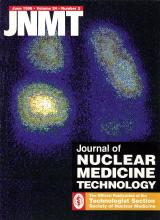Abstract
Objective: Physiological uptake sites and secretion of 131I are potential causes of misleading images. This case report demonstrates 131I accumulation in the nose as a hot spot.
Methods: A 40-year old woman with papillary thyroid carcinoma was scanned following the oral administration of 185 MBq 131I, 6 mo after surgery and 131I therapy.
Results: Whole-body and spot images of the head and neck revealed localized tracer uptake in the nasal region and in the thyroid bed due to residual thyroid tissue. The lateral view showed soft tissue accumulation in the distal portion of the nose. Static images were acquired after the patient scoured her nose and mouth of secretions. Marked decrement of the activity confirmed the presence of radioactive mucus.
Conclusion: Nasal secretion of 131I may cause nasal hot spot appearance that can lead to false positive interpretations in thyroid cancer patients. This case report emphasizes the importance of evaluation of physiological uptake sites.







